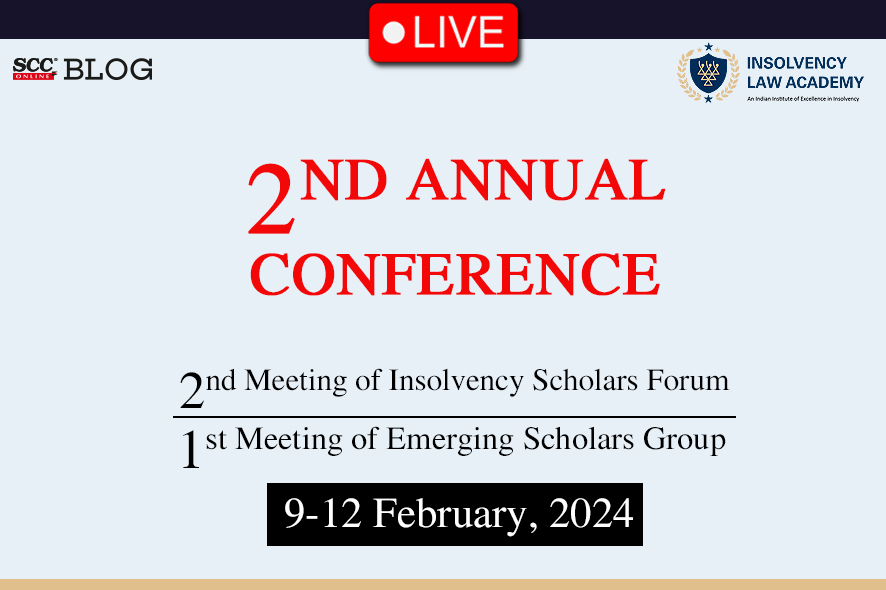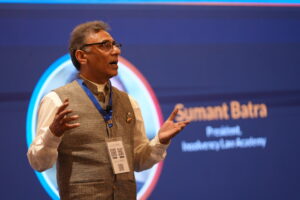ILA is holding its 2nd Annual Conference, the 2nd meeting of ILA’s Insolvency Scholars Forum and 1st meeting of ILA’s Emerging Scholar’s Group from 9th to 11th February, 2024 (ILA 2024) in Goa. The blog here covers live updates from the specific sessions of the event.
Opening Session [Venue- Diva Pavilion]
ILA: Past, Present and Future: Sumant Batra, President, ILA will present the work done,
in pipeline and proposed to be undertaken in future, by ILA.
Special Address:
Scott Atkins, President, INSOL International
Keynote Speaker:
Sanjeev Sanyal, Member, Economic Advisory Council to the Prime Minister
Mr Sumant Batra President, ILA talks about the work done, in pipeline and proposed to be undertaken in future, by ILA.
What you need is a thought process where you learn from the best,
says Mr Sumant Batra
Mr Batra talks about key points focussed by ILA:
- Business Development
- Bank Insolvency
- Municipal Debt Restructuring
- MSME Insolvency
- Individual Insolvency
- Pre-Insolvency And Preventive Resolution
- Price Discovery Optimization
- Avoidance Transactions
- Cross Border Insolvency
- Impact Assessment
Agenda in 2024-27
- Voice for Emerging Markets
- Municipal Debt Restructuring
- Bank Insolvency
- Constructive Disruption
- Insolvency and Climate Change
- Ancient Wisdom
Special Address
Scott Atkins, President, INSOL International
Mr Atkins talks about INSOL International and the vision is to deliver set growth.
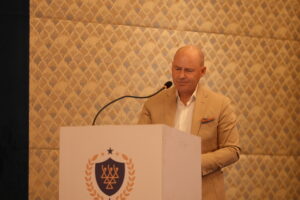
He also focussed on helping maximising economic value and encouraging discussions about insolvency holds importance.
He talks about the Building Block 2021- strategic plan of INSOL of modernizing the governance system and to grow to build regional engagement.
INSOL Board and leadership plans to bring future leaders. The Education programme are built to encourage to keep writing and learning opportunities and successful engagement.
Mr Sanjeev Sanyal, Member, Economic Advisory Council to the Prime Minister, talks about being third largest economy but we are poorest country because of third largest population. In order to sustain in the economy, it is critical to our model that insolvency and bankruptcy works.
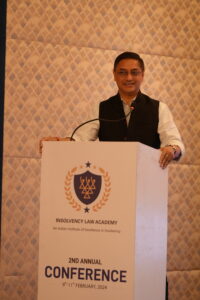
He shares story of bringing IBC and shared about the financial crisis in 2007-2008 and fast Bank credit 2007- 2012.
In the year 2014, it was realised that something was going wrong with the banking system started to get stressed. Problems with the banks and NPA continued and keep going up as high as 11% and for PSU – 14%.
Earlier, repayment of bank loan was seen an option, but with the introduction of IBC, NPA declined to 3.2%.
Insolvency is not a rocket science but most of it is a common sense.
-Sanjeev Sanyal
Panel Discussion on : Insolvency Policies and Systems: The Global Shifts and Developments
Global events in last few decades have persuaded governments around the globe and international institutions to make resilience central in the insolvency policy strategies and policy-guiding principles. This approach clearly derives from the growing uncertainty and complexity that policymakers are faced with. There is a growing recognition of the importance of policy designs that can address or minimize the impacts of potential shocks and uncertainty. Many countries have recently reviewed their insolvency policies. Others are presently reviewing their insolvency laws, actively to consider new approaches to insolvency. This session will discuss the international developments in the insolvency space and the emerging policy choices.
Scott Atkins, President, INSOL International
Nicholas H Moller, Principal Counsel, Office of General Counsel, Asian Development Bank
James Sprayregan, Founder Kirkland & Ellis Worldwide Restructuring Group
Antonia Menezes, Senior Financial Sector Specialist, The World Bank Group
Moderated by Sumant Batra, President, Insolvency Law Academy
Antonio says the World Banks International National Standard alongside UNICITRAL ensures modern and best practice are adopted in order to provide guidance on enterprise work role. Other models adopted are electronics platforms and development of insolvency systems and e courts during the pandemics.
DAY 2
Mr Sumant Batra announces creating Task force on Insolvency Laws Emerging Markets and Developing Economies.
The Task Force will
- Organise Academic Activities in the field of insolvency laws in emerging economies;
- Hold Virtual meetings to discuss topics, projects and strategies to promote academic and policy debates on insolvency laws in emerging economies.
Panel Discussion on IBC 2.0: The New Wave of Insolvency Reforms in India
To strengthen further the functioning of the Insolvency and Bankruptcy Code, 2016 and add unique solutions, the Government of India announced, in January 2023, proposals to consider a raft of changes in the Code, including fast-tracking the process, expanding the scope of the pre-packed framework, use of mediation and developing an electronic platform with minimal human interface. A plan for improvements in relation to the admission of corporate insolvency resolution process (applications, streamlining the insolvency resolution process, recasting the liquidation process, and the role of service providers under the Code was also unveiled. The Insolvency and Bankruptcy Board of India set up an expert committee to consider and make recommendations on use of mediation in insolvency. Many of the proposals are expected to get implemented by the end of the year. This session will discuss this new wave of insolvency reforms in India to further improve the Indian insolvency system.
Speakers
Abhijeet Sinha, Senior Advocate, Supreme Court of India
Sudhaker Shukla, Whole Time Member, Insolvency and Bankruptcy Board of India
Dinkar Venkatasubramanian, Head, Restructuring & Turnaround, EY Restructuring LLP, President, INSOL India
Moderated by Suharsh Sinha, Partner, AZB & Partners
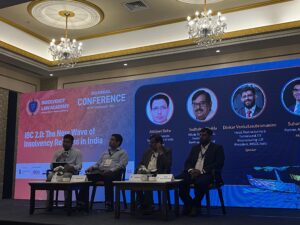
Mr Abhijeet Sinha while addressing to Mr. Sudhakar Shukla regarding IBC’s 2-3 success points thus far?
Mr Sudhaker Shukla contends that, first and foremost, the data is clear, and the regimes that existed before and now are essentially more in line with change, which was carefully maintained. The greatest strength of the IBC is that we replied with 6 revisions and more than 100 interventions, reflecting market demand. Second, earlier, there was ease of access and competitiveness, but there was no freedom of escape. As a result, there is now an exit strategy for market failures. Third, credit culture has evolved. Debtor’s paradise has been lost. The goal is resolution.
On the question of strength of IBC, Mr Abhijeet Sinha says that the judgments by our courts take a balanced approach. The speed at which regulatory framework has been complimented by the judiciary is the strength of IBC.
Mr Dinkar Venkatasubramanian also spoke about how pre-packs & mediation can be made more successful. He further talks about the current situation of IBC as today, the imperative is different. There is a need for private capital. The speed with which creditors can take control.
The tendency till today is to push the problem for a later date.
On the question of Pre-packs, Mr. Sinha says if the pre-packs extended to large companies and with full protection of 29A. All companies should have this option when a company gone into insolvency must be seen as it has been run by the defaulter be it a directors mindset or the management issue.
On the question of prepacks to be suggested to large companies, Mr Shukla says that Problem statement is Section 29A and solution is Pre-pack. As a regulator, we are proposing that instead of extending Pre-packs to Non-MSMEs, we are proposing CLRA.
Mr Dinkar Venkatasubramanian on whether it was a Genuine business failure and malafice, says that Coming to prepack as a solution if we have to resolve, the onus is on the lenders to decide whether it is a malafice or actual business failure.
Session 2: Insolvency Law in Emerging Markets and Developing Economies
Emerging markets and developing economies (EMDEs) represent about 85 percent of the world’s population and 60 percent of the global gross domestic product (GDP). Today, they are the main drivers of economic growth for the world. Yet, most insolvency debates have traditionally focused on advanced economies. Despite the international divergences existing among EMDEs, these countries generally differ from advanced economies in several aspects, including level of economic and financial development, as well as the existence of weak market and institutional environments. Therefore, the solutions or policy recommendations often proposed for advanced economies might not be suitable for EMDEs. The particular features of EMDEs require solutions tailored to the reality existing in these countries. It is becoming increasingly clear that legal transplants do not work, and even less when they are adopted in countries with totally different market and institutional environments. Therefore, insolvency law in emerging economies requires different thoughts, strategies and policy approaches, apart from a more active academic and policy debate. For that reason, Insolvency Law Academy has established a Standing Task Force on Insolvency Law in Emerging Markets and Developing Economies to groom the field of ‘insolvency law in emerging markets and developing economies’ on the world map and promote this area of insolvency law almost like a new discipline that require different solutions and academic thinking. This session by the Task Force will seek to enrich the public discourse and academic literature with the features and challenges of the insolvency framework in EDMEs.
Speakers
Prof. Aurelio Gurrea Martinez, Singapore Management University, Head, Singapore
Global Restructuring Initiative, Singapore
Prof. Anthony J. Casey, Deputy Dean, Donald M. Ephraim Professor of Law and
Economics, University of Chicago, U.S.A.
Steven Kargman, Founder & President, Kargman Associates, U.S.A.
Saroj K. Ghimire, Advocate, Supreme Court of Nepal
Kiran Chonkar, Partner, Corporate Finance & Investment Banking, Deal Advisory Services, BDO India
Moderated by Pooja Mahajan, Managing Partner, Head, Insolvency & Restructuring, Chandhiok & Mahajan

On the question by Ms Pooja Mahajan on current regime and challenges of Nepal, Mr Saroj K. Ghimire says that the gamete of insolvency is still not addressed in the Insolvency Law. Till now, the Insolvency law is only to administer and not address the current issues and challenges. however, he did pointed out that the entrepreneurs wrong doing does exclude them from participating in social gatherings and mostly it gives out a negative connotation.
Mr Steven Kargman while talking about role of controlling shareholders says that they are not eager to enter into any insolvency.
Mr Kiran Chonkar while talking about insolvency law for Emerging markets says that Each market is unique and various challenges. Hence, solution has to be taken a way. Two points which are important i.e. Policy infrastructure and second is that infrastructure will implement the policy. He also spoke about maximising stakeholder value and in the entire process, minority shareholders gets completely ignored.
While talking about restructuring, Prof Anthony Casey says that every type of restructuring has problems and every kind of tailoring has problems.
Prof Aurelio Gurrea Martinez, talks about exploring ways to minimise ways for involvement of judiciary. He further suggested hybrid proceedings scheme of arrangement preventive restructuring and pre-packs sale of assets. In 2022, it used to take 600-650days whether the company will end up in insolvency.
Prof Kargman spoke about litigation issue effecting the timings and strict timeline are being breached, parties not acting in good faith of conduct. He further said that the parties need to have pragmatic approach of the issues discussed. He also said that Good degree of transparency cannot be perceived as a constructive way.
Mr Kiran Chonkar says that cross border insolvency elements is an unknowing animal wherein more access to asset and ability to get back those assets and investments needs to be resolved for better restructuring.
Prof Anthony J. Casey says that You don’t need your financial system in place to set up the better restructuring process but it has be the mindset.
Session 3: Maximising Value of Distressed Assets: Importance of Legal and Rescue Finance
The Insolvency and Bankruptcy Code (Code) has progressed by in leaps and bounds in a very short span of time. Due to effective implementation of the Code, green shoots have already emerged. However, there are concerns over lack of optimum price discovery for distressed assets. There is a need to further deepen market for distressed assets resolution and better price discovery. Optimisation of price discovery is dependent on many factors. State of secondary market for distressed assets, quality and integrity of valuations, availability of interim finance, and use of litigation funding are amongst the elements that
influence price discovery.
Last mile financing, in the Indian context, the post-petition financing (interim finance) is a way for Companies into resolution proceedings to finance themselves for pressing funding needs, whether for keeping their operations going or cover the costs associated with the process. IBC accords “super priority” status to creditors who provide interim finance to companies in distress. The market for interim finance is yet to develop in India. IBC also allows the liquidator to assign the receivables that are not readily recoverable to pave way for early closure of enterprise. Often the need to assign may arise because of lack of funds to pursue costly litigation. Third-party litigation funding is a popular way in many developed economies to overcome this constraint. There are dedicated ventures that specialise in such kind of funding. Litigation Funding is likely to emerge as an important part of the financial sector and can eventually make India’s justice delivery system more efficacious and accessible. ILA and Burford Capital are Undertaking a study in this area. The panel will discuss the preliminary observations of collaborative study.
Chair: Vijay Iyer, Partner, Deloitte
Presenters
Dr. Sulette Lombard, Associate Professor in Law: UniSA Justice and Society, Adelaide, South Australia
Sanjeev Pandey, Part time Advisor, Centre for Advance Financial Research and Learning, Reserve Bank of India
Respondents
Shweta Bharti, Managing Partner at Hammurabi & Solomon Partners
Joe Durkin, Senior Vice President, Burford Capital, Dubai

While talking about litigation funding, Dr Suletter Lombard says Litigation funding can be very useful. With respect to academic perspective, litigating can be done via hiring a litigation funder and later, the fruits of the litigation are shared with the funder.
Ms Shweta Bharti says that the acceptance has been given by Courts to third party funding. IBC does not forbid third party funding. There are situations where interim finance is not possible.
Mr Sanjeev Pandey also bats for third party funding and since India is in a public sector market.
Mr Joe Durkin says in some countries, champerty is not barrier in third party funding.
While talking about legal barriers, Ms Bharati says that there are no legal barriers in India. Third party funding being possible in India. There are few Advantages of the same:
- Super priority payments;
- Minimum return that could be returned;
- promoting some endeavour from IBBI;
- Balance of interest amongst stakeholders – alignment of thoughts.
Mr Sanjeev Pandey on return on investment said that litigation funding cannot cover such space specifically due to strict timelines.
On the question of Personal guarantees to corporate debtors and Banks can go to unearth the debts, what is the best way of litigation funding, Dr Lombard says that the best way to get litigation funding is to passive and active investments.
On being question by Mr Vijay Iyer regarding whether a Security Interest is a challenge to interim finance, Ms Bharati clears the air by saying that the security interest is not a challenge. However it is taking care of interim financers.
Mr. Pandey says that having a database is like actually creating a market & by make it online through public registers and having maximum number of people to participate will be the game changer.
Mr Durkin says that there is lot of international asset sitting outside and looking for a home in India and India has big opportunities.
Ms Bharati talks about requirement of awareness and how such conferences are helpful in spreading awareness.
Dr Lombard talks about the requirement of research being undertaken for effective implementation of Third party Funding.
She discussed certain issues:
- There are instances/cases wherein Litigation Funder would charge 75% to funder and 25% to the insolvent company.
- India is in a fortunate position to balance it out and we need to be on same page.
Interim finance is not just to meet the funds of litigation but to run the CIRP says Mr Vijay Iyer.
Session 3: Implementing Individual Insolvency – Preparing the Foreground
In more than seven years, the Insolvency and Bankruptcy Code, 2016, remains inoperative for all natural persons, except the guarantors of corporate debt. This essentially leaves most individuals, proprietorships (which constitute the majority of Indian micro, small, & medium enterprises, and partnerships (which are not limited liability entities,) at the mercy of colonial legislation’s, which were products of the then political economy. As one may expect for a country of nearly 1.5 billion, demographic heterogeneity is inevitable. On one hand, there are individuals higher up in the economic pyramid who can endure or often instigate long drawn and arduous litigation’s to optimize their relief under any insolvency and bankruptcy regime, on the other hand there are also low-income households and enterprises who may need additional protections under the bankruptcy regime. Thus, looking at the present status, of the personal insolvency matters, there is huge opportunity for performing extensive research which in turn will help in strengthening India’s insolvency and bankruptcy framework for natural persons.
Insolvency Law Academy and Dvara Research Foundation (Dvara) have jointly established a Chair for Individual Insolvency to serve as a home for various research projects relating to insolvency of individuals and unregistered partnerships and proprietorships. The first for individual insolvency to be established in the country, the Chair focuses on the research to help strengthen India’s insolvency and bankruptcy framework for natural persons and, micro, small and medium enterprise.
In this session, the Chair will present its work on going work on insolvency of individuals and MSMEs
Chair: Dr. Shubhashis Gangopadhyay, Dean, School of Liberal Studies, University of Petroleum and Energy Studies
Presenter
Dr. Indradeep Ghosh, Executive Director, Dvara Research Foundation
Mr Debanshu Mukherjee, Co-Founder, Vidhi Legal

Mr Ghosh, talks about personal insolvency and retail market credit. His paper on personal insolvency focuses on part 3 of IBC i.e
- what number of households would qualify for first fresh start process;
- which lays out 4 criteria’s; and
- what number would quantify to be forgiven.
He further explains about qualification of HHs via income and expenditure criteria. Expenditure criteria is the basis of all poverty thresholds in India.
The quantity of debt which needs to be forgiven is minuscule as per the data below:
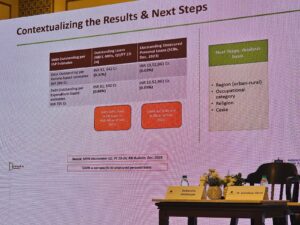
Mr. Deebanshu said that in 2019 insolvency Law Committee realised that this part of law has been hanging in the legislation. Soon after the report came out, the pandemic happened and it has not been moving at all. He also spoke about the personal Insolvency issues inter-wined with some of social issues. In general view, Corporate lending is coming down but overall lending is not coming down but moving to personal space in the nature of Personal Insolvency. The Eco-systems needs to start thinking about it that has been hanging on for so long.
Session 4: Pre-Insolvency Resolution
Following the fall of Lehman Brothers and the ensuing financial crisis, the world has witnessed a proliferation of various ‘light touch’ financial restructuring techniques in the form of pre-insolvency proceedings. These proceedings inhabit a space on the spectrum of insolvency and restructuring law, somewhere between a pure contractual workout, the domain of contract law, and a formal insolvency or rehabilitation proceeding.
Policymakers around the globe have responded to market developments by embarking on an aggressive new phase of corporate rescue oriented legislative endeavour that focuses on pre-insolvency or preventive insolvency proceedings. The Government of India is also actively considering introducing fast-track corporate insolvency resolution process to provide an opportunity for the financial creditors to drive the insolvency resolution process for a corporate debtor outside of the judicial process while retaining some involvement of the Adjudicating Authority under the Insolvency and Bankruptcy Code, 2016, to improve the legal certainty of the final outcome. An Expert Committee set by the Insolvency and Bankruptcy Board of India constituted an expert committee to propose the framework for creditor-led fast track resolution process – a hybrid of pre-insolvency and formal resolution process, has submitted its report in July 2023.
Insolvency Law Academy has established a Chair for Pre-Insolvency Resolution, supported by Ernst & Young India, and Chandhiok & Mahajan, to undertake research and other activities in pre-insolvency resolution (pre-pack, fast track and other forms of pre-insolvency processes) and related areas for the benefit of insolvency ecosystem in India and beyond; promote preventive insolvency practices; develop best practices for per-insolvency resolution and preventive insolvency; and design and deliver educational and training programmes.
In this session, the Chair will present its work in the area of pre-insolvency resolution.
Presenter
Nitin Jain, Partner, Ernst & Young LLP
Prof. Aurelio Gurrea Martinez, Singapore Management University, Head, Singapore
Global Restructuring Initiative, Singapore
Dr. Siddharth Srivastava, Partner, Restructuring & Insolvency, Khaitan & Co
Moderated by Bahram N. Vakil, Co- Founder, AZB & Partners
Mr Nitin Jain discusses alternative pre-pack insolvency process to address the delays and optimise value of assets through a creditor led hybrid insolvency model bearing benefits of both debtor-in-possession and Creditor in Control model. It combines the benefits from RBI’s Prudential Framework for Resolution of Stressed Assets Dated June 07, 2019 with statutory backing to make the out of court resolution process more effective.
Key Benefits of Proposed Purposes:
- Allow parties to initiate negotiation at an early stage of distress when the symptoms of an impending distress appear, without having to wait for an actual event of default. An early intervention can be crucial in turning around a business and prevent value erosion and plug leakages.
- The model is expected to provide incremental benefits where financial distress is caused on account of systematic issues such as economic downturn, change in regulations , recession etc rather than any management related aspects.
- Provide greater flexibility to creditors;
- Prevent disruptions and value erosion caused by taking over management and operations of CIRP.
- Cost effective and reduce time;
- Provide statutory sanctity and judicial enforceability for an out of court largely consensual resolution process negotiated by relevant stakeholders.
Session 5: Emerging Scholars Group Session: Cross-Border Insolvency
The Emerging Scholars Group (ESG) is a platform that brings together young academicians and professionals together from around the globe and provides them with an opportunity to research and participate in discourse relating to Insolvency Laws in order to improve approaches to national and international practice, promote professional excellence, collegiality, and scholarship. This initiative is part of ILA’s larger vision to systematically develop and mentor young scholars in insolvency. ESG members’ skills, resources, and goodwill will be utilized by ILA in its numerous projects and initiatives.
For its inaugural meeting, ESG invited papers from young scholars around the world. The papers selected by the Chairs of ESG are being presented in these sessions.
Chair: Dr. Eugenio Vaccari, Senior Lecturer in Law, Department of Law and Criminology, Royal Holloway, University of London, UK
Presenters
Prof. Ishana Tripathi, Associate Professor, O.P. Jindal Global University (insolvency- related judgments)
Alok Verma, PhD Student, The Zvi Meitar Center for Advanced Legal Studies, Tel Aviv University – The Buchmann Faculty of Law (cross-border insolvency in India)
Mrinalini Srivastava, PhD. Scholar, Gujarat National Law University (international group insolvencies)
Commentators
Prof. Aurelio Gurrea Martinez, Associate Professor of Law, Singapore Management University; Head, Singapore Global Restructuring Initiative
Ashish Chhawchharia, Partner, Recovery & Reorganisation, Grant Thornton Bharat LLP

Mr Alok Verma talks about Realigning Perspectives: India’s policy shift and its impact on Cross Border Insolvency.
Ms Ishaana Tripathi talks about Reciprocity in India in three steps :
Step 1: Recognition : Code of Civil Procedure offers jurisdiction recognition.
Step 2: Decree and judgment enforcement and execution.
Step 3: Execute the decree though the time spent is 3 – 10 years.
Ms Tripathi also shares the case where winding up period stayed execution of foreign decrees which courts did not execute for a period of 3-4 years in cases of Kingfisher Airlines and United Breweries. Most foreign decree-holders of recognized territories left remediless due to inactions by the promoters.
Ms Mrinalini Srivastava discusses about Ordering International Group Insolvency: Lex Lata and Lex Ferenda. She also talked about having Ex-Ante regulations and equitable remedies to prevent acts of insolvency and preventing harm.
Prof. Aurelio Gurrea Martinez centered his focus around the concept of COMI (Centre of Main Interests) of registered office to promote to prevent the veil As it creates litigation. He says that if companies in there constitution in their AoA can mention where the proceedings should be initiated which will be good for the creditors.
Mr. Ashish Chhawchharia gave his practical perspective on jet airways and discusses about the protectiontism.
Prof. Ishana Tripathi, and Mr. Ashish Chhawchharia deliberated their views on Jet airways Case study on how the judge struggled with section 238 of IBC & Moratorium of assets and rights of creditor having the decree.
Dr. Neeti Shikha directed the views of everyone on modification on model law, success of enforcement of judgement.
creditors need to know how to settle.
Mr. Ashish Chhawchharia said it would have been wonderful if there was would have been any kind of framework which would have ultimately have helped the RP’s and Trustees on both the side to make jet airways resolution successful.
Session 5: Insolvency from the lens of emerging scholars
Chair: Mariam Zaidi, Senior Legal Officer, Piramal Capital & Housing Finance
Presenters
Aditya Sushant Jain, Law Student, O.P. Jindal Global University (AI and insolvency)
Preeti Nalavadi, Associate Teacher of Law & PhD Candidate, Adelaide Law School, Faculty of Arts, Business, Law and Economics, The University of Adelaide (SME insolvency) Raja A.K., Trainee, Deloitte & Student, post graduate Insolvency Programme & Sneha V., Trainee, Stressed Asset Management, YES Bank; student, post graduate Insolvency Programme Student (Financial institutions)
Commentator
Prof. Wan Wai Yee, Adjunct Professor, CITY University Hong Kong; Co-Chair, Insolvency Scholars Forum.
Aditya Sushant Jain raised question having data protection for the airways companies but not for the tele-companies. He also pointed on black box concerns on lack of education on technology in law schools.
Ms Preeti Nalavadi spoke about MSME Landscape in India. She also shared Indian Business Structures which is complicated businesses. Based on the reports, she raised question whether IBC conducive towards SME?
The problem on unorganized sector : the promoter issue; structural issues and part III applies to corporate debtors only. She also questions whether we are failing Amartya Sen’s theory being welfare society.
Mr Raja A.K. talks about business failures due to preventable, unavoidable and Intelligent reasons. He emphasised on the strong and credit culture. He also covers the issues concerning globally recognised real estate sectors.
He spoke about the need for shift in credit culture by putting an emphasis on assessment based credit method; business based combination & risk mitigation.
Prof Wan Wai Yee raised her concern and was bit skeptical on what is the potential of AI technology to predict early insolvency quite concerned about the blockchain technology as it is not registered its gonna be inevitable the downside is fraud and misuse which would otherwise no legal system would recognise it. She expresses that the potential of AI in collecting database is unexplored.
According to her, social welfare theory can be used to construct the social welfare and mold them as per the existing laws in India although we don’t have the laws for non corporate entities and can mold them to our larger benefit.
Dr Neeti Shikha suggested the panelist about connecting the dots and work on narrow areas to see it through.
The event concluded by the announcement of the short story prize winners to the following participants:
Winner: Mr Rav Pratap Singh,
First Runner Up: S. Badri Narayana
Second Runner Up: Mayur Jagwat
Third Runner Up: Anjali Mukaty
The prizes of the the competition were sponsored by Chambers of Eshana Kumar.
Day 3
Dr. Neeti Shikha, Lecturer, University of the West of England; Chair, Insolvency Scholars Forum welcomes everyone on the Day 3 of the Conference. Ms Shikha appreciates the efforts of ILA in bringing young professionals. She also thanks Prof Wan Wai Yee for showing the guiding light.
Ms Shikha appreciates the efforts of Mr Sumant Batra for building an Academy with a great vision on shaping insolvency laws.
Mr Sumant Batra welcomes the dignitaries and also, highlights that this area is going to get more attention from the Government soon. A new revised Bill tabled before the Parliament – we would help the regulators in research and policies and thought process perspectives. We would provide a note to RBI with certain suggestions in improving the policies.
Mr Batra focuses on two important perspectives which needs focus:
1. Municipal Restructuring Framework;
2. Insolvency in Climate Change.
Mr Batra welcomes Justice Sanjay Kishan Kaul, Former Judge, Supreme Court.
Justice Sanjay Kishan Kaul, Hon’ble former Judge, Supreme Court of India. We have faced challenges when the economy will grow, challenges will grow as people like to spend a quality of life. There is always a reluctance to pay taxes.
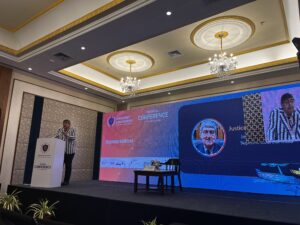
Mr Kaul shares as covid 19 has seen lot of disruptions and post covid 19, we saw fallibility. Mr Kaul talks about the restructuring by bringing younger talent. It is time that whole system thing is out of the box. The Problem arises when cases stuck in the system such as in NCLT and NCLAT, timelines have been laid down but yet those timelines are crossed again and again. Approval of resolution completed 17% and completion of CIRP has come up from 324 days to 625 days as on September 2023.
Justice Kaul presses the need of good talent and shared that someone capable is not willing to join judiciary. There are many challenges which needs to be addressed on time in order to make implementation of the insolvency laws successful.
It is better to think about having experts as specialised jurisdictions in High Courts. In so far as adjudicating process is concerned, we are looking for retired judges. Hence, if we can bring more experts in specialised tribunals can be more effective.
Justice Kaul also talks about Case Management system and the time period has to be strictly adhered to. It is important to note that Supreme Court cannot interfere at every stage hence, structuring of the system is required.
Justice Kaul also bats for Mediation system in which you get structured solution within a time-frame with the consent of the parties. Lastly, he added about the concepts of pre-packs. We are facing a challenge of employability and deprival of this creating a huge problem. Only handful of companies opted for pre-packs. The recommendation must go to the policy makers and it is important to think out of the box. The participation in such conferences helps think out of the box.
On the question asked by Dr Neeti Shikha on the law not giving more discretion as per the research done in past, Justice Kaul expresses that its a mixture of law & art, a more structured way of dealing which needs to be followed.
ISF Session 1: Bank Insolvency Resolution: Framework for India
The UNIDROIT project on Bank Insolvency aims at addressing the current gap in the international legal architecture, by developing an international soft law instrument covering the key features of bank liquidation proceedings. The preparation of a guidance document on Bank Insolvency is expected to be adopted in near future.
In India, the Financial Resolution and Deposit Insurance (FRDI) Bill was introduced in the Parliament in the year 2017 to deal with insolvency of firms in the financial sector. In 2018, the Bill was withdrawn owing to multiple reasons. Discussion on the need for insolvency law for financial institutions continued albeit passively. This discussion has gained momentum in recent time. As the government considers various options, it would be required to make many significant policy choices.
In the meantime, Insolvency Law Academy has set up a Thought Committee of experts on bank insolvency, chaired by Dr. T.K. Visvanathan, former Union Law Secretary and chairman of Bankruptcy Law Reforms Committee to deliberate on the issues arising from bank insolvency and make suitable recommendations.
Following the presentation by UNIDROIT on the international guidance document, the panel of experts and regulators will discuss how crisis management and resolution framework can be best adopted for banks, financial institutions and non-bank financial institutions in India, taking into account global developments, including the United States, European Union and Asia Pacific. To what extent to these models need to be adapted for India? Which regulator should be responsible for the resolution proceedings of financial institutions? What is the optimal resolution or insolvency model for global systemically important banks?
Speakers
N.S. Vishwanathan, Former Deputy Governor, Reserve Bank of India
Bahram Vakil, Co-Founder, AZB & Partners
Sumant Batra, President, Insolvency Law Academy
Moderated by
Abizer Diwanji, Head – Financial Services, Ernst & Young India
Mr Sumant Batra is now voice to the Government and Mr Bahram Vakil is a veteran on whom RBI trusts, says Abizer Diwanji.
Mr Diwanji spoke about difference between Financial sector insolvency and normal sector insolvency is that it is eliminating the Board members therefore, section 277 was introduced by not allowing the board to participate in the process.
Mr N.S Vishwanathan, talks about extent and pretend i.e when the IBC came the RBI said that if banks are stressed we need to go towards to narrow banking arrangement. In the history of RBI, we have never seen a failure, but subsequently, post nationalisation, normal solution was to merge private sector bank with public sector bank. Post 2016, RBI did some restructuring and took some market based approach. Mr Vishwanthan further explained that FRDI was a product of the legislative committee which is outside the micro prudential regulation. Being covenant of task force – put it within the regulator and there shouldn’t be dual intervention.
As far as banks are concerned, creditors cannot go to the court. He further explained role of DICGC:
1. Pay box system
2. Settle claims on withdrawal of license or a scheme being approved.
3. Subrogation- steps in to the shoes of the small depositors.
Mr Sumant Batra talks about IBBI nomenclature. Mr Diwanji suggests that dealing with distress and resolution can be delegated to a different body.
Mr Bahram Vakil, points out that it is not run by RBI but initiated by RBI. When the system wants to move fast and it can be amazingly quick. When IRDAI is involved, bidder are taking benefit of delay.
Articulate the rules properly so that there is clarity on who does what
says N.S Vishwanathan
ISF Session 2: Bank Resolution and Corporate Insolvency Law
There is a general consensus among regulators globally that general corporate insolvency is not suitable to resolve holding companies of banks and financial institutions in distress, given the complexity involved, the impact to depositors and to other connected institutions. However, there is no consensus on the optimal bank resolution model. There are also grave moral hazard problems associated with government bailouts for the financial sectors. As a result, countries have introduced special resolution regimes for financial institutions. This panel will discuss the regulatory models that are used, including the planning process that modify the structure of complex financial institutions to facilitate resolution, the use of bail-ins, the allocation of responsibility among the national regulators, changes to the deposit insurance regimes and how global systemically important banks are dealt with.
Chair:
Dr. M.S. Sahoo, Advocate; Former Distinguished Professor National Law University
Delhi; Former Chairperson, Insolvency and Bankruptcy Board of India; Member, ILA
Global Advisory Board
Paper Presenters
Dr. Neeti Shikha, Lecturer, University of the West of England, Chair, Insolvency
Scholars Forum
Dr. Virág Blazsek, Lecturer, School of law, University of Leeds, U.K.
Prof. Ilias Kapsis, Senior Lecturer, City University, London
Commentator: Anoop Rawat, Partner, Shardul Amarchand Mangaldas
Dr Sahoo spoke about broad Henry VIII clause which allowed Government to modify basic provision in IBC in case of ambiguity. IBC was the largest legisation Government has written at that time. It was also outsourced. Typically for financial providers, we have different legislation elsewhere. Today, the provisions related to Pre-pack are longer than the corporate insolvency.
Dr Neeti Shikha talks about why small banks matter; resolutions options and issues which are required to be addressed. Dr Shikha talks about post SVB Bank failure, Government of England has come up with certain suggestions.
The way small banks are perceived globally is different. ‘Small’ banks is not just small but it may include bigger banks. These small banks are crucial to Indian economy and they are doing lot of retail lending.
Substantial body of empirical research shows that small banks are more willing to deliver bank loans.
Dr Shikha also poses a question whether modified resolution toolbox, developed primarily with large complex banks in mind to small and medium deposit taking institutions?
Dr Shikha discusses Stabilisation options:
- Merger
- Bail In
- Private Sector Purchaser (PSP)
- Bridge bank
Essential to improve crisis management model for medium sized banks in order to safeguard financial stability.
Dr. Virag Blazsek through her paper discusses about the finding of the her book “the fallacy of bail – in as a bank resolution strategy which proposes to develop the crisis management toolkit.
3 main issues that were addressed by the Dr Blazsek are:
1. what does Bail in-mean as a bank resolution strategy?
2. what does experience tell us about the feasibility of bail out?
3. what are the inherent failure of the bail in strategy?
Dr Virag while explaining ‘Bail in’ said that ‘Bail in’ is internal capitalization. She also commented that although she does not criticize it completely but the argument that she made that the bail in is not a effective tool to support the financial institution. Bail out is the can be opted only once the bail has been done with.
She also mentioned about some of the theoretical issues of the Bail-in & Bail out during her discussion.
Mr Anoop Rawat reframe it by using it in the context of Insolvency resolution and questioned Dr. Virag in order to understand the insolvency resolution in a crisis situation.
Public Debt in India is 57% of the GDP whereas the Public debt is 100 t0 150 % of the GDP in the world.
said Dr Blazsek
Dr Ilias Kapsis discusses the treatment of unsecured depositors in Bank Resolution/Insolvency through the following:
- Uninsured depositors: a growing problem in bank failures;
- Lessons from 2023 financial market turmoil;
- Search for solutions on the UD issue;
- Evaluating the various law reform proposals.
He further discussed the case of failure of SVB and Signature Bank in US and the forced acquisition of Credit Suisse by UBS in Switzerland in March 2023 and how the same got triggered.
He shared the lessons from 2023 Turmoil :
- Emergency powers and unorthodox solutions were used restoring market stability but potentially undermining the credibility of bank insolvency;
- UK demonstrated the slow insolvency/liquidation process may note be suitable for resolving the Uninsured depositors issue – Need for timely solution.
- Protection of Uninsured depositors’s sacrifices stakeholders and the other creditors who face increased losses;
- Industry or public funded deposit schemes may have to take losses to protect Uninsured depositors’s.
Also, in his concluding remarks he spoke about the complex legal landscape for UDs in Bank Insolvency Resolution and how some countries use liquidation to provide aid or to arrange deposit transfers.
ISF Session 3: Bank Resolution in Recent Times
Following from the earlier panel, this panel discusses the workability of the bank resolution models in the jurisdictions that have adopted special regimes for financial institutions post global financial crisis of 2008, and what are the lessons that are usefully learnt. For instance, what are the problems arising from how Silicon Valley Bank are dealt with? Should the regulators write down Credit Suisse’s AT1 bonds instead of using the resolution tools?
Chair: N.S. Vishwanathan, Former Deputy Governor, Reserve Bank of India
Paper Presenters
Myrte M. T. Thijssen, Legal Officer, UNIDROIT
Prof. Anthony J. Casey, Deputy Dean, Donald M. Ephraim Professor of Law and
Economics, University of Chicago
Commentator:
Abizer Diwanji, Head – Financial Services, Ernst & Young India
Ms Myrte M. T. Thijssen talks about UNIDROIT project on Bank Insolvency. The context and need for International Guidance
working Group and process and objective and envisaged output.
She also talks about UNDRIOIT helping countries make their bank liquidation frameworks more effective. Bank insolvency is mix of private law and regulatory law. Hence, UNIDROIT partnership with Financial Stability Institute. The working Group has been constituted.
She discusses key aspects of bank liquidation tools for appropriate institutional set up; provisions allowing a timely and swift opening of bank liquidation proceedings;and adequate safeguards.
If you want to sale bank assets and liabilities of banks, there is a requirement of various formalities.
Bail in for non systematic banks does not work well.
I. Effective Liquidation Tools: Drawbacks of ‘piecemeal liquidation’: destruction of value; disruption of access to deposits, possible broader adverse effects;
The legal framework should allow and facilitate a ‘sale as a going concern’: transfer of a bank’s assets and liabilities – especially (insured) deposits to another bank to allow continued operation.
– Power for the liquidation authority / liquidator to transfer a non-viable bank’s assets and liabilities to a sound acquirer.
– Without the need to individually notify, or obtain consent from, shareholders.
– Enabling the liquidation authority / liquidator to prepare and execute transfer.
II. Appropriate Institutional Set Up: Bank Liquidation proceedings should ideally be managed by an administrative authority. She also discusses Solutions for jurisdictions that do not adopt a fully administrative model.
III. Timely and swift opening of bank liquidation proceedings: The legal framework should enable timely action and swift opening of bank liquidation proceedings to prevent unnecessary destruction of value.
IV: Funding and Creditor Hierarchy: The legal framework should allow the provision of external funding to ensure an orderly liquidation.
V. The legal framework should provide adequate substantive and procedural safeguards.
Ms Thijssen suggests that instead of pay out to depositors, you can use the same amount to pay other liability.
Prof Casey present his paper on the silicon valley bank in post crisis bank failure. Prof Casey discusses the SVB case. He also discusses instances of Bank failures alongwith resolution options. Prof Casey rested this paper by addressing to the audience by asking should we scrap the bank deposit insurance limit?
Mr Diwanji, clarifies that clear distinction of non systematic banks is required. Non-symstematic is vulnerable and in many countries, lot of buffer has been given to such banks. However, the biggest moral hazard is giving 100% money to everybody. Most of the exemptions are politically motivated.
He also discusses silicon valley case where they were not doing the kind of treasury management that they were supposed to do and no corrective actions were also taken.
On the question of role of central bank in-bank liquidation, Myrte Thijssen said that the same being jurisdiction specific, has to be decided as per jurisdiction.
ISF Session 4: Sovereign Debt Restructuring
During the COVID-19 pandemic, national debt levels have increased to deal with the economic fallout arising from the crisis. Some low and middle-income countries are finding difficult to fulfill debt obligations and face downgrades in their sovereign debt
ratings. Sovereign debt restructurings raise complex issues, which will be discussed in this panel. Should there be equitable sharing of burdens between private and public creditors when sovereigns default and if so, what would be the ex-ante impact on the lending market? What should be the role of global bodies such as the IMF?
Paper Presenters
Prof. Christoph G. Paulus, Of Counsel, White & Case LLP, Germany
Steven Kargman, Founder & President, Kargman Associates, USA
Commentator
Dr. Virginia Torrie, Estey Chair, university of Saskatchewan College of Law; Editor-in-
Chief, Banking and Finance Law Review, Canada
Moderated by
Gausia Shaikh, Legal Analysist, REDD Intelligence
Prof. Christoph G. Paulus starts with drawing everyone’s attention on some of the fundamental deliberations about advantages and disadvantages of a sovereign proceedings.
* Structural Inadequacies’ is a highly political issue and from that dimension we are now turning now to a regionalization.
* the struggle of supremacy between the creditors & Debtors – quoting law can only give a structure to the
And also deliberated the issues kenya has been facing, the debt service 57% not be paid. they are in the debt trap. Many similarities can be drawn from the commercial insolvency law and defaulting states such as common pool problem & pari passu invitation to negotiation etc.
Advantages:
1. Political
2. Economical
3. Legal
4. An Idealistic admonition – golden rule of reciprocity – Germany has defaulted twice in last 250 years, they generally end with a state default faulted twice in last 250 years, they generally end with a state default.
Prof. Steve Kargman – presented his paper on the brave new world of sovereign debt restructuring: The “China conundrum” and other challenges –
Wherein he discusses about the Last few years for emerging and developing economics and how it has been difficult, and just when they were recovering from it the war in Ukraine hit. Along with that Prof. Steve Kargmen highlights how higher interest rate policies has been real reason for such sovereign defaults.
According to the data he gives an brief overview on the sovereign debt records which says that since 2020-2023 there has been 19 sovereign defaults, 15 already in sovereign debt distress and 45% in the state of sovereign debt defaults. Defaults. by giving example of Zambia with estimated 15 billion dolllars, Sri Lanka & Ghana with approx. 63Billion dollars
Complex composition of creditors bodies:
1. Bilateral creditors
2. International Financial Institutions
3. Bondholders
4. Commercial Lenders
Dr. Virginia Torrie addresses the issue of transparency. We need to have everything transparent minus politicizing. Complete transparency in not always optimal in reaching to a resolution but presence of major players in the room. She also emphasised in having discussions and discussing ideas on the issues.
Session 4: Municipal Debt Restructuring
Urban areas contribute a considerable part to the economic development of a country. The urban local bodies are the principal catalysts for guiding urbanization. Municipalities need funds to deliver high quality services. Large infrastructure projects in developing countries increasingly tap into capital markets for financing. Their fiscal empowerment, when seen from this perspective, is a necessity. In recent years, municipal bodies have been increasingly accessing the public debt markets by issuance of municipal bonds.
However, there are many impediments in accessing municipal bonds. To be able to raise funds from the market, a Municipality needs to be able to make credible, legally enforceable promises to repay. A Municipality that has borrowed may default because of
its financial distress or insolvency.
There is a pressing need for an in-depth comprehensive study to identify the policy gaps and legal grey areas in accessing finance by Municipalities and offer solutions to the problems. An efficient insolvency system underpins investment and economic growth
and creates wealth. An insolvency law for Municipalities can create a sound climate for investment, and enable their market participation, more accurately price, and manage and control default risks and failure. This in turn will help Municipalities become engines of economic growth and provide high-end services to the citizens.
ILA, National Institute of Securities Market and Janaagraha Centre for Citizenship have jointly taken thought leadership in this area and undertake a comprehensive study. This panel will discuss the unique dynamics of municipal debt restructuring, share experiences, and help in setting the agenda for work in this area.
Opening Comments
Sumant Batra, President, Insolvency Law Academy
Speakers
Dr. Eugenio Vaccari, Senior Lecturer in Law, Department of Law and Criminology, Royal Holloway, University of London, UK
Hon’ble Justice A.K. Sikri, Former Judge, Supreme Court of India, Chairman, ILA Global Advisory Board
Dr Eugenio talks about what is at stake when local public entities in financial distress. He explained the Local Public Entity as a public authority or entity which is partially or totally funded by tax levies and provides for the provision of public services i.e. essential services with a colletive or social dimensions not necessarily in the market place but at the local communities at heart
its types:
1. Basic
2. Hybrid LPE.
He further discussed his analyses as a part of the project where LPEs are a significant part of everyday life. The internal project resulted in four primary approaches, such as Comprehensive special insolvency systems; comprehensive administrative systems; Fragmented or special administrative systems; light touch approaches.
Themes:
1. Uncertainty
2. Divergent approaches to governance
3. Divergent Procedures
4. Collectivity
5. Continuity of essential services
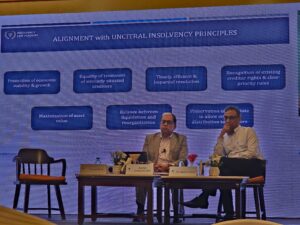
Dr Eugenio also emphasised on alignment with UNICITRAL Insolvency Principles. Later, he discussed about the key challenges on Defining an LPE consistently; limiting political interference; need for a modular and model approach; need for an inter disciplinary approach.
Justice Sikri speaks about the framework of Municipal Debt Restructuring. Justice Sikri shares a Delhi High Court instance where a petition is pending in High Court where Municipality authority is unable to pay salaries of its employees and that’s the kind of debt situation that we are facing being the fundamental right .
‘Pay salary arrears or we will wind up MCD’ said by Chief Justice of Delhi High Court.
Justice Sikri talks about the constitutional status of Municipal Corporation as it has been created under Constitution. States have the power to pass a law to create a municipal corporation. There are essential services which comes under the functions of Municipal Corporations. Under the Act, they have power to levy taxes on buildings etc. Inspite of generation of money through taxes, they go through financial distress. He discusses two kinds of challenges i.e. political or administrative.
Justice Sikri hopes for better resolution for distressed municipal corporations.
Mr Sumant Batra shares the idea of holding three roundtable conferences in India and one on municipal corporations as well.
Justice Sikri notes that the work needs to be done. In case Municipal corporations are unable to perform, it can be handed over to a private enterprises.
Dr Eugenio in its concluding remarks he appreciated that there are 3 countries that have excellent preventive measures first being South Africa, Italy & Japan
Vote of Thanks:
Prof. Wan Wai Yee, Adjunct Professor, CITY University Hong Kong, Co-Chair, Insolvency Scholars Forum gives closing remarks and this brings to an end of the Three Days successful Conference.
DAY 4
ILA – IIULER1
ROUNDTABLE ON MEDIATION IN INSOLVENCY
Monday, 12th February 2024, IIULER Campus, Goa
In association with INSOL India
The enactment of the Insolvency and Bankruptcy Code, 2016 (“Code”) was a watershed moment in India for recovery of business enterprises in distress. Over the past more than seven years, law and practice of insolvency has matured to focus on entire value chains in addressing enterprise sickness and on the resolution of disputes through creditor in control and collective deliberation process. However, despite the significant improvements brought by the Code, the insolvency resolution process is still considered to be time-consuming and resource intensive.
A sound insolvency system is non-adversarial in design and process. Yet disputes may arise between parties in the process. Experience shows that multifarious disputes arise between the parties in processes under the Code. These disputes clog the boards of NCLT. To reduce the burden of NCLT, it is necessary to enable and promote alternative options to resolve disputes.
Mediation has emerged as an effective tool of dispute resolution in many jurisdictions,and attained the status of ‘Appropriate Dispute Resolution’ mechanism. It offers strong incentives for parties to engage and look for a common business solution. Mediation can arguably serve a greater purpose since resources are limited and the need to save time and preserve business relationships is arguably higher. It being non-adversarial in approach can help in maintaining cordiality in business relationships and save honest entrepreneurs from the stigma of insolvency. Although it has not been used extensively in insolvency proceedings in India, its acceptability had rapidly increased in jurisdictions around the world. With the passing of Mediation Bill, 2023, the use of mediation is expected to gain momentum in India.

Prof. (Dr.) R. Venkata Rao, Vice Chancellor, India International University of Legal Education and Research (IIULER), Goa gave the welcome remarks.
Mr. Sumant Batra gave the opening comments for the final day. He thanked all the dignitaries and the attendees for being there and for attending the conference.
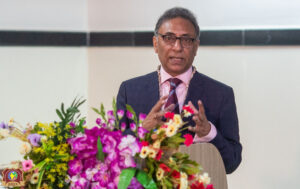
Justice Sanjay Kishan Kaul, Former Judge Supreme Court of India, said that mediation has a structural aspect to it. The efficiency of the insolvency proceedings is based on timelines. The concept of continuous business relationships is a very important part of the mediation.
“Mediation is not a substitute for the IBC, but a supplement and complement to it.”
-Justice Kaul
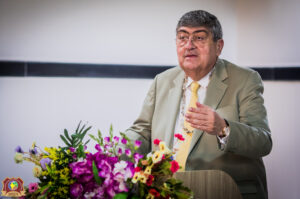
Session 1: Mediation Act, 2023: An Overview
Ms. Iram Majid, Executive Director, Asia Pacific Centre for Arbitration and Mediation talked about the historic moment when India signed the Singapore convention, which laid down the foundation of Mediation Law in India. She gave an overview of the Mediation Act, 2023. She said that this Act is the cornerstone for the formalization and development of the institution for Mediation in India. It has given a progressive shift towards efficient, voluntary and mutually agreeable dispute resolution through Mediation.
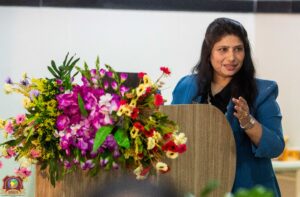
Session 3: India: Future of Mediation in Insolvency
Speakers
Sudhaker Shukla, Whole Time Member, Insolvency and Bankruptcy Board of India
Justice A.K. Sikri, Former Judge, Supreme Court of India, Chairman, ILA Global Advisory Board
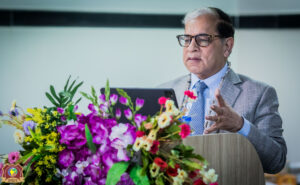
Mr. Sudhaker Shukla talked about the history and existence of mediation in Indian culture since ages. Mr. Shukla said that pre-filing mediation is an important aspect. He discussed the Supreme Court’s view that the process related timelines are sacrosanct. Regarding the 120 days timeline provided in the Act, he said that it is very aggressive and does not suit the process.
Justice A.K. Sikri said that there should be a legislation for insolvency proceedings and mediation, but not separate from the Mediation Act. He stressed the need for robust institutions for mediation. Mr. Sikri talked about two types of mediation, firstly, facilitating mediation and secondly, evaluating mediation. He also said that we can try to create an ecosystem within the Act and try Insolvency mediation proceedings.
Session 4: India: Future of Mediation in Insolvency
Mr. Suharsh Sinha said that the practitioners should be aware that in case the mediation does not result in settlement, the aggrieved party should not make that justiciable before the NCLT. Mediation in IBC needs to be flexible, with less technicalities and procedures.
Closing Remarks
Mr. Dinkar Venkatasubramanian, Partner, EY India thanked everyone for the outstanding conference. He said that mediation is a bridge which acts between traditional or commercial court proceedings and IBC proceedings. He said that trust of both the parties is a key ingredient in the insolvency mediation.



